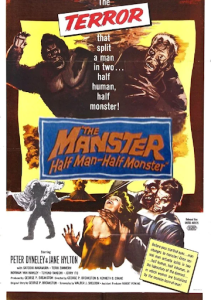 The Manster (1959) by #GeorgePBreakston #KennethGCrane
The Manster (1959) by #GeorgePBreakston #KennethGCrane
w/#PeterDyneley #JaneHylton #TetsuNakamura #TerriZimmern
An American journalist stationed in Japan is given a mysterious injection by a mad scientist, turning him into a murderous, two-headed monster.
“The TERROR that split a man in two… half human, half monster!”
#Horror #SciFi
#NotQuiteClassicCinema
#FridayNightAtTheHomeDriveIn
The Manster (1959) opens with what appears to be two bathing beauties – perhaps naked – in a natural pond of some sort. Then we see another woman inside of a house with shoji, or “doors, windows, and room dividers used in traditional Japanese architecture, consisting of translucent (or transparent) sheets of paper on a lattice frame.”
Suddenly, a shadowy figure appears and slides the shoji closed, obscuring the woman from our sight. We see, through the shoji, as the woman’s shadow is attacked by the shadow of what could only be a wild beast of some sort. As blood spray hits the closed room divider, and the title sequence begins, we realize that we are watching one of the finest motion pictures ever produced…
Really? It’s that good?
Wait, there’s more…
After the opening credits are finished, we return outdoors to see the two bathing beauties dead in the water. We may not have seen what happened to them, but we can be pretty certain that a monster – or man-ster – is on the loose…
Just thinking about this opening sequence makes me want to watch the movie all over again…
What is The Manster about?
Set in Japan, it’s a transformation story – sort of like a werewolf movie, or maybe a Dr. Jekyll and Mr. Hyde movie – but different.
A doctor slips an experimental serum into an American reporter’s drink. The American, Larry Stanford (played by Peter Dyneley), begins to have fits of… anger… or sexual violence, maybe? It’s a little unclear at first. Later, we see his hand transforms into a hairy werewolf type hand. Larry also sees this happen and is quite upset.
For the most part, the transformation is subtle. Halfway through the movie, we still haven’t seen a full on transformation (and we’re actually wondering what the end result might be). Larry has had a few moments where something is clearly wrong, and eventually he attacks and kills someone off screen.
So, is it a monster movie or not?
The movie starts off with the full on monster movie feel, but it becomes more of a serious drama in a way. A story of a man who is away from home, away from his wife, and suddenly begins to slip into drinking and womanizing. He is the victim of a mad doctor’s experimental treatments, although he doesn’t know that.
Didn’t the description say something about a two-headed monster?
Yes, it did. And I should have remembered that. But when the full reveal off Larry’s new monstrous state finally happens, it’s not only shocking, it’s pure cinema gold (or perhaps I should say #NotQuiteClassicCinema gold).
As a side note, apparently Sam Raimi paid homage to The Manster in Army of Darkness (1992). In both movies, the main character finds an eye growing out of his shoulder, which then turns into a whole second head (in The Manster) or a whole second person (in Army of Darkness). If that doesn’t tell you how cool The Manster is, then I don’t know what will.
So what’s the final word on The Manster?
The Manster (1959) is #NotQuiteClassicCinema of the highest order. I don’t know how I missed it all of these years, but I will definitely be watching it again in the future. I would suggest that anyone with the taste for Sam Raimi, 1950s Japanese horror, or two headed monster movies should immediately schedule it for their next #FridayNightAtTheHomeDriveIn.
#FridayNightAtTheHomeDriveIn
The Manster (1959) by #GeorgePBreakston #KennethGCrane
w/#PeterDyneley #JaneHylton #TetsuNakamura #TerriZimmern
An American journalist stationed in Japan is given a mysterious injection by a mad scientist.#Horror #SciFi#NotQuiteClassicCinema pic.twitter.com/VYWRV9Rdlk— Angus Kohm (@AngusKohm) April 13, 2024
